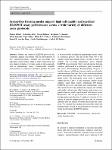Serum-free freezing media support high cell quality and excellent ELISPOT assay performance across a wide variety of different assay protocols
Filbert, Helene
Attig, Sebastian
Bidmon, Nicole
Renard, Bernhard Y.
Janetzki, Sylvia
Sahin, Ugur
Welters, Marij J. P.
Ottensmeier, Christian
Burg, Sjoerd H. van der
Gouttefangeas, Cécile
Britten, Cedrik M.
Robust and sensitive ELISPOT protocols are commonly applied concomitant with the development of new immunotherapeutics. Despite the knowledge that individual serum batches differ in their composition and may change properties over time, serum is still commonly used in immunologic assays. Commercially available serum batches are expensive, limited in quantity and need to be pretested for suitability in immunologic assays, which is a laborious process. The aim of this study was to test whether serum-free freezing media can lead to high cell viability and favorable performance across multiple ELISPOT assay protocols. Thirty-one laboratories from ten countries participated in a proficiency panel organized by the Cancer Immunotherapy Immunoguiding Program to test the influence of different freezing media on cell quality and immunologic function. Each center received peripheral blood mononuclear cells which were frozen in three different media. The participants were asked to quantify antigen-specific CD8+ T-cell responses against model antigens using their locally established IFN-gamma ELISPOT protocols. Self-made and commercially available serum-free freezing media led to higher cell viability and similar cell recovery after thawing and resting compared to freezing media supplemented with human serum. Furthermore, the test performance as determined by (1) background spot production, (2) replicate variation, (3) frequency of detected antigen-specific spots and (4) response detection rate was similar for serum and serum-free conditions. We conclude that defined and accessible serum-free freezing media should be recommended for freezing cells stored for subsequent ELISPOT analysis.
Dateien zu dieser Publikation
Keine Lizenzangabe
Verwandte Publikationen
Anzeige der Publikationen mit ähnlichem Titel, Autor, Urheber und Thema.
-
2011-05-01ZeitschriftenartikelIgY Technology: Extraction of Chicken Antibodies from Egg Yolk by Polyethylene Glycol (PEG) Precipitation Pauly, Diana; Chacana, Pablo A.; Calzado, Esteban G.; Brembs, Björn; Schade, RüdigerHens can be immunized by means of i.m. vaccination (Musculus pectoralis, left and right, injection volume 0.5-1.0 ml) or by means of Gene-Gun plasmid-immunization. Dependent on the immunogenicity of the antigen, high ...
-
2010-10-31ZeitschriftenartikelDirect Visualization of Peptide/MHC Complexes at the Surface and in the Intracellular Compartments of Cells Infected In Vivo by Leishmania major Muraille, Eric; Gounon, Pierre; Cazareth, Julie; Hoebeke, Johan; Lippuner, Christoph; Davalos-Misslitz, Ana; Aebischer, Toni; Muller, Sylviane; Glaichenhaus, Nicolas; Mougneau, EvelyneProtozoa and bacteria infect various types of phagocytic cells including macrophages, monocytes, dendritic cells and eosinophils. However, it is not clear which of these cells process and present microbial antigens in vivo ...
-
2010-01-13ZeitschriftenartikelHLA–B27 heavy chains distinguished by a micropolymorphism exhibit differential flexibility Fabian, Heinz; Huser, Hans; Loll, Bernhard; Ziegler, Andreas; Naumann, Dieter; Uchanska-Ziegler, BarbaraObjective: Although the products of the HLA subtypes B*2705 and B*2709 differ only in residue 116 (Asp versus His) within their peptide-binding grooves, they are differentially associated with inflammatory rheumatic ...

